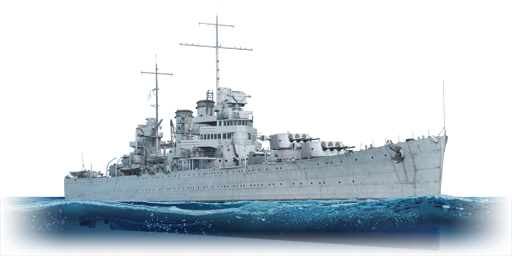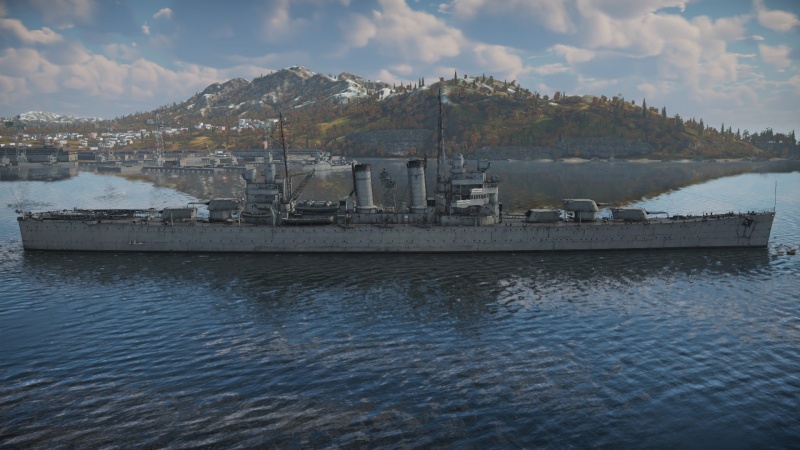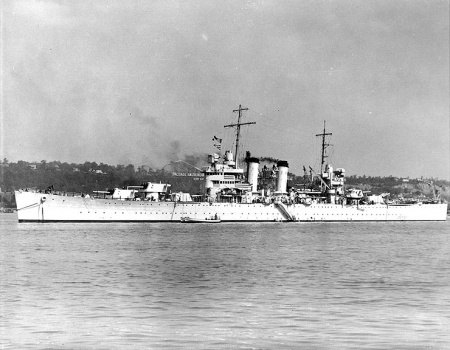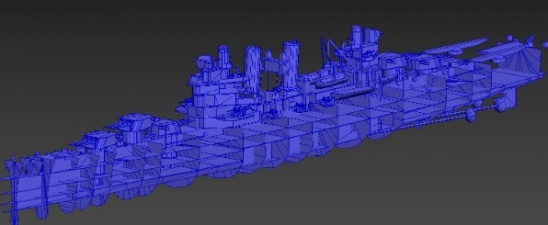USS Brooklyn
Contents
Description
The Brooklyn-class, USS Brooklyn (CL-40), 1941 is a rank V American light cruiser with a battle rating of 6.0 (AB/RB/SB). It was introduced in Update 1.87 "Locked On".
General info
Survivability and armour
The Brooklyn is protected by both sheer internal volume and thick armour around vital components. The turrets are easily the most protected in the game, with 165 mm of rolled cemented armour on the turret face, 75 mm of RHA on the turret sides, and 152 mm of antifragmentation armour on the ammo elevators.
Bow ammunition storage is stored below the waterline, and it is protected not only by 51 mm of antifragmentation armour but also by a "wrapped" fuel tank that can absorb incoming shells.
Mobility
Manoeuvrability is what should be expected for a 12,242-ton vessel: sluggish.
| Mobility Characteristics | |||
|---|---|---|---|
| Game Mode | Upgrade Status | Maximum Speed (km/h) | |
| Forward | Reverse | ||
| AB | |||
| Upgraded | 70 | 21 | |
| RB/SB | |||
| Upgraded | 60 | 18 | |
Modifications and economy
Armament
Primary armament
Brooklyn has a devastating primary armament of fifteen 6"/47 Mk.16 cannons, arranged in triple turrets with three in front and two in back. With a rate of fire of 10 rounds per minute this makes Brooklyn have some of the best offensive ability among all other ships in the game. All of the turrets have a horizontal guidance limit of ±150° and a vertical guidance limit of -5°/+40° which does allow for limited anti-aircraft fire, but only at longer ranges which avoids more extreme elevation. The turrets do have a slow traverse rate of 4.3 °/second which can cause issues at closer ranges as well as switching between targets.
The 6"/47 Mk. 16 cannons have access to four different types of ammunition:
- 6 inch Mk. 34 HC: This is the standard HE shell, with a muzzle velocity of 812 m/s (2,665 f/s) and a TNT equivalent explosive mass of 5.88 kg. Standard HE shells have a near instantaneous detonation as this shell has a fuse delay of 0.35 m, so it is best used on unarmoured targets or on targets that the HE shell can penetrate that have a small internal volume. This is the default shell for the Brooklyn.
- 6 inch Mk. 35 AP: This is an APCBC that is able to unlocked, with a muzzle velocity of 762 m/s (2,500 f/s) and a TNT equivalent explosive mass of 866.32 grams. The penetration of this shell is very respectable compared to similar ones (such as the German 15cm/60 SK C/25 (150 mm) and the Soviet 152 mm/57 B-38 (152 mm)) and will hold its penetrative ability out to longer ranges, only dropping below 100 mm at 0° past 10 km. The fuse delay is 9 m, meaning that this shell is best used against heavily armoured targets with larger internal volumes (essentially, other cruisers). Due to the low explosive mass of the shell, precise aiming will be necessary. Typical targets of AP shells will be engine and machinery rooms as well as ammunition storage.
- 6 inch Mk. 34 HC (Base Fuse): This an HE shell that is nearly identical to the default HE shell with the only difference being a base detonating fuse rather than a point contact fuse. This shell has a fuse sensitivity of 10 mm and a fuse delay of 3 m (as opposed to 0.1 mm and 0.35 m, respectively, for the default shell). This makes the shell less effective against small targets such as torpedo boats as the shell may pass through the target without detonating. Slightly larger targets that do not have heavy armour can be heavily damaged with this shell, as it will detonate further inside the ship's volume.
- 6 inch Mk. 34 HC (VT): This is, again, nearly identical to the default HE shell with the only difference being that it is fitted with a variable time fuse. The sensitivity and delay are the same as the default HE shell with a trigger radius of 23 m. Like other HE-VT shells, these can still be used as normal HE shells against surface targets but will detonate in the air if an aircraft is detected within the trigger radius. As these shells have almost double the explosive mass of the 5/38 Mark 12 Dual Purpose (127 mm) found on American destroyers (as well as Brookyln's secondary armament, the 5 inch/25 Mk.13 AA (127 mm)), any aircraft caught by these shells will be eviscerated. The major factor holding these shells back is the limited elevation of the guns to only +40° and the slow traverse rate, which means that any agile aircraft at closer ranges and/or high altitude are not affected by this shell. Larger and slower aircraft at low/medium altitude are the best targets for these shells.
Secondary armament
Brooklyn has a total of eight 5"/25 Mk.13 cannons, with four on each side of the ship at amidships. Three on each side are on the main deck level and have a firing angle of 180° while two are mounted on an elevated deck facing forward and have a horizontal guidance limit of 40°/160°. All of the cannons have a vertical guidance limit of -10°/+85° which allows them to engage both air and surface targets. A horizontal 17 °/second gives them good flexibility to track aircraft as well as faster moving motor boats. A quick rate of fire at 20 rounds per minute also aid in taking down targets before they get too close or escape behind cover.
The 5"/25 Mk.13 AA cannons have access to two different types of ammunition:
- 5 inch Mk. 36 AAC: This is the default HE shell with a mechanical delay fuse. They have a muzzle velocity of 657 m/s (2,155 f/s) and a TNT equivalent explosive mass of 3.16 kg. As these are delay fuses set at the moment of firing, they are affected by the Gunner crew skill "Distance fuse set accuracy" and do need a ranging shot fired before the fuse can be set accurately. These shells are rendered effectively useless after unlocking the Mk. 28 AAC-VT shell.
- 5 inch Mk. 28 AAC-VT: These shells are identical to the Mk. 36 AAC with the exception being the usage of a VT shell rather than a mechanical time delay fuse. This gives the shell more flexibility and destructive potential against aircraft thanks to the VT fuse. The trigger radius is 23 m.
Anti-aircraft armament
The Brooklyn comes with eight 12.7 mm (.50 cal) AN-M2 machine guns, which act the last line of defense against aircraft and small surface craft. They are all located on elevated decks around the superstructure evenly spread, four of them port and starboard as well as fore and aft. The actual defensive capability provided by these is almost negligible, and relying on them to take out enemies will only be a mistake.
The 12.7 mm AN-M2 machine guns come with only a default ammunition belt (API-T / AP / I / AP).
Scout plane
Located on the stern are two catapults with one OS2U-1 scout plane each which provide unique offensive and defensive abilities, expanding tactical options. Ship-launched scout planes fly just like regular tree units but lack munition choices and cockpit views. Alongside the typical abilities of strafing, dropping 2 x 100 lb bombs, and capping zones, the OS2U-1 and other scout planes have the added ability to lay down smoke cover (up to 3 times). Captains will be wise to remember to utilise the aircraft and consider when best to use it, for example to cap a point early or late in the match, to create a smoke screen to stymie enemy bombardment and repair, to attack enemy units directly, or perhaps something completely new! With two scout planes one can risk a cap attempt at the beginning of the match, saving the second for any opportunity that presents itself.
Usage in battles
The Brooklyn is easily the strongest ship in War Thunder. Combining adequate protection with unparalleled firepower, it can hold its own most other cruisers without much threat to itself. If isolated, a Brooklyn can be taken down by a group of cruisers or even destroyers via ammo racking. If, however, the Brooklyn is integrated into a team of CLs, the chance of defeating it becomes far lower.
The main threats to the Brooklyn are the Kirov, Southampton, and Furutaka. It is advised to engage these targets first and other cruisers second; the Kirov and Furutaka have sufficient firepower to threaten a Brooklyn, and the Southampton's armour dampens the firepower advantage of the Brooklyn.
Pros and cons
Pros:
- Great broadside firepower for a cruiser, has multiple useful ammo options
- main battery magazines and engine compartments are submerged and well-protected
- Highly resilient to fire hazard thanks to complicated internal bulkheads
- Two scout seaplanes
Cons:
- Open single mount 5-inch auxiliary guns are subpar to US standardized twin mount guns
- Floodfighting is slow among all cruisers
History
USS Brooklyn (CL-40) was the lead ship of her class of light cruisers built for the United States navy before the start of the Second World War. Built to counter the Mogami class of light cruisers built by the Japanese navy, the ships were the most heavily-armed light cruisers of their era. Brooklyn served in the Atlantic Theatre during the Second World War, escorting convoys and providing fire support. After the end of the war, she was given to Chile, and served for 40 more years before she was retired and scrapped in 1992.
Design and development
As the London naval treaty limited the amount of heavy cruisers with 8-inch main armament, the American naval designers decided to create a ship displacing 10 thousand tons with a 6-inch main armament. As well, they found that a light cruiser with a 6-inch main armament could overwhelm a comparable heavy cruiser due to their higher fire rate. As a result, the designers pushed forward with a new 6-inch armament light cruiser: the Brooklyn class. However, during Brooklyn's design process, it was discovered that the Japanese intended to arm their new Mogami class with fifteen 6-inch guns. As a result, the Brooklyn's design was amended to include an additional 3-gun turret mounted in a rear-facing non superfiring position. Brooklyn was built to this design starting from March of 1935, and was completed by September of 1937.
Brooklyn was 185 metres long and displaced exactly 10 thousand tons standard, and 12 200 tons full. She had a main armament of fifteen 6-inch (152 mm) guns in five triple turrets, three fore and two aft. The #3 turret, mounted ahead of the superstructure, faced backwards and was unable to fire forwards. Her secondary armament consisted of eight 5-inch (127 mm) guns in single mounts and her anti-aircraft armament initially consisted of eight 12.7 mm AN/M2 machine guns. Her engines delivered a total of 100 000 shaft horsepower (shp), allowing her a top speed of 32.5 knots (60 km/h).
Operational history
After her commissioning, the Brooklyn joined the American Atlantic fleet and joined fleet exercises in the Atlantic for a short time before passing through the Panama canal to attend fleet exercises on the west coast, as well as the Navy Exposition of 1940. In March 1941, she departed again to enter the Atlantic, where she would stay until the start of the Second World War. Upon the declaration of war by the United States, Brooklyn was immediately assigned to convoy escort duty, and soon after rescued sailors from the troop transport USS Wakefield, which had caught fire during an Atlantic convoy voyage.
In October of 1942, Brooklyn was sent to North Africa to cover the allied landings that were happening as a part of Operation Torch. When Vichy French naval units attempted to flee from the port of Casablanca, the Brooklyn opened fire upon them, along with other units of the task force including the battleship USS Massachusetts. During this time, she damaged the destroyers Brestois and Milan, while the cruiser Primauguet was eventually sunk by a combination of air attack and fire from the Massachusetts. She was attacked by a French submarine, but escaped unharmed.
After this conflict, known as the Naval battle of Casablanca, the Brooklyn was once again dispatched to perform convoy escort duties. Between January and July of 1943, she made three convoy runs between the east coast and Casablanca, and later participated in the Sicily landings of late 1943. She provided fire support for the Anzio-Nettuno landings of early 1944, and remained in the Mediterranean theatre until December of that year, when she returned to the United States for an overhaul. However, due to the cessation of hostilities that year, Brooklyn was retired. In 1951, she was given to the Chilean navy, who renamed her O'Higgins. She went on to serve for over 40 years, finally being retired and scrapped in 1992. One of her turrets is preserved at a Chilean navy base; she earned 4 battle stars for her WWII service.
Devblog
In 1930, the London Naval Treaty extended the limitations imposed by the Washington Naval Treaty by further limiting the construction of large warships. Well-aware of the importance of such warships for operations in the Pacific, the U.S. Navy initiated the development of a new light cruiser design that would suit their needs, whilst remaining within the limitations of both treaties. The new design, that would become the Brooklyn-class light cruisers, was a compromise between heavy cruiser size and protection and light cruiser armament. In other words, the ship would remain within the 10,000-ton displacement limit, but would also offer the desired seaworthiness and autonomy at the same time.
Initially, the ship was intended to carry only a dozen 6-inch main guns. However, with the appearance of the Japanese Mogami-class cruiser, a decision was hastily made to increase the number of main guns to 15, in order to match the armament of the Mogami-class. With this choice, the Brooklyn-class cruisers would become the most heavily armed light cruisers ever built for the USN. The first orders for four ships were issued in 1933, followed by an additional three in 1934. The lead ship of the class, USS Brooklyn (CL-40), was laid down in March 1935 and commissioned into service in September 1937.
USS Brooklyn primarily served in the Mediterranean theatre during WW2, participating in the North African campaign and later on in the Italian campaign. The ship mostly served as a support in landing operations and performed coastline bombardments, while also engaging in the occasional naval skirmish. Soon after the end of WW2, USS Brooklyn was decommissioned in 1947 and handed over to the Chilean Navy in 1951 under the new name of O'Higgins (CL-02). The ship would continue to serve on with the Chilean Navy for over 40 years, before being sold for scraps in 1992.
Media
- Skins
- Images
Damage model of the ship viewed in 3D Max, as revealed by the developers during the QA session on 6 February 2020
- Videos
See also
External links
References
- Evans, M. L. (2019, January 10). Brooklyn III (CL-40). Retrieved January 26, 2021, from https://www.history.navy.mil/research/histories/ship-histories/danfs/b/brooklyn-iii.html
- Helgason, G. (1995). USS Brooklyn. Retrieved January 26, 2021, from https://uboat.net/allies/warships/ship/2566.html
| Brooklyn Navy Yard | |
|---|---|
| Cruiser, Light (CL) | |
| Brooklyn-class | USS Brooklyn · USS Helena |
| Heavy Cruisers (CA) | |
| Pensacola-class | USS Pensacola |
| Battleships (BB) | |
| Pennsylvania-class | USS Arizona |
| USA light cruisers | |
|---|---|
| Omaha-class | USS Detroit · USS Raleigh · USS Trenton |
| Atlanta-class | USS Atlanta |
| Brooklyn-class | USS Brooklyn · USS Helena |
| Cleveland-class | USS Cleveland |
| Fargo-class | USS Fargo |
| Worcester-class | USS Roanoke |







